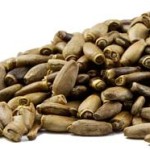 Milk thistle is a member of the sunflower family native to a narrow area of the Mediterranean. It has since been naturalized throughout Europe and can commonly be found in Oregon and California where it is considered a common garden weed. Despite this unsavory reputation, milk thistle has quite a striking appearance, noted by the large pink or purple flower growing atop its solitary stem. The edible thistles were given the name silybum by Dioscorides, a Greek physician who served in the Roman Army over 1,900 years ago. The thistle with white mottling on its leaves became known as the “milk” thistle. In Catholic Germany, its usefulness was said to be second only to calling on Mother Mary, and the white mottling on the leaf is said to be the touch of the Virgin Mary’s milk, hence the species name “marianum.”
Milk thistle is a member of the sunflower family native to a narrow area of the Mediterranean. It has since been naturalized throughout Europe and can commonly be found in Oregon and California where it is considered a common garden weed. Despite this unsavory reputation, milk thistle has quite a striking appearance, noted by the large pink or purple flower growing atop its solitary stem. The edible thistles were given the name silybum by Dioscorides, a Greek physician who served in the Roman Army over 1,900 years ago. The thistle with white mottling on its leaves became known as the “milk” thistle. In Catholic Germany, its usefulness was said to be second only to calling on Mother Mary, and the white mottling on the leaf is said to be the touch of the Virgin Mary’s milk, hence the species name “marianum.”
About Milk Thistle
The leaves of the milk thistle are edible and can be consumed as a potherb. Because the thorns must be snipped off before preparation as a food item, commercial distribution is impractical. Nevertheless, the leaves make a delicious addition to salads, tasting similar to lettuce. Three of the active compounds within milk thistle seed are collectively identified as silymarin. This constituent is credited for much of milk thistle’s medicinal value, particularly that which is associated with healthy liver support. The German Commission E has approved an extract of 70% silymarin in supporting healthy liver function. The Commission has also approved milk thistle in its crude form for minor dyspeptic complaints.
Milk Thistle is also known as Silybum marianum, Holy Thistle, Variegated Thistle, Lady’s Thistle.
Constituents: Silymarin (silibinin, silydianin, and silychristin), vitamin E (tocopherols), and about 90% fatty acids.
Parts Used: The threshed, dried seed.
Typical Preparations: Whole seeds or seed powder, encapsulated or used to make an infusion. The most convenient form has been either an alcohol or glycerin extract.
Precautions: Like silymarin extract, milk thistle seed can cause mild diarrhea by stimulating the release of bile. This effect is most notable if there is a high-fat diet.
